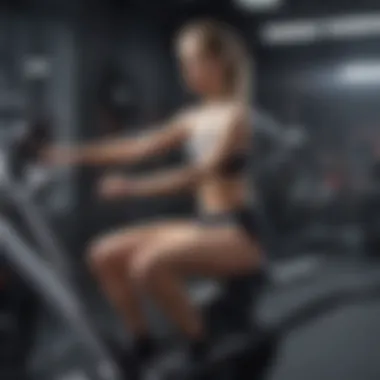Mastering Ski Erg Technique for Peak Performance


Intro
In the realm of fitness, the ski erg machine often stands in the shadows of its more popular counterparts—treadmills and stationary bikes. However, its significance is undeniable, as it mimics the motions of cross-country skiing and provides a full-body workout. To harness the full potential of this machine, understanding the nuances of ski erg form becomes paramount. Proper technique not only enhances performance but also reduces the risk of injury. This piece will take a deep dive into the essential aspects of ski erg form, uncovering key techniques and common pitfalls.
Key Takeaways
- Importance of Form: Maintaining proper form is crucial for maximizing efficiency and reducing the likelihood of injury.
- Common Mistakes: NEW users often fall into the trap of over-extending or insufficient hip engagement, which can alter performance.
- Individualization: Tailoring your approach based on personal fitness levels and goals can lead to better outcomes.
- Physiological Benefits: A well-executed ski erg workout can improve cardiovascular health, muscle strength, and endurance.
Essential Techniques for Ski Erg Form
Getting the basic techniques right is where many novices falter. The first step is to observe proper posture. Your back should be straight, with a slight bend at the knees and hips.
Lower Body Engagement
Your legs play a significant role in taking advantage of the equipment. Rather than solely relying on your arms, ensure:
- Knees are driving the motion from the starting position.
- Feet are firmly placed in the foot straps for stability.
- Legs should engage in a sequence that rhythmically complements the pulling action of your arms.
Upper Body Mechanics
The upper body should act as a powerful extension of your lower body. Key points include:
- Arm Movement: Pull straight back in a smooth line, keeping elbows close to your body.
- Core Activation: Keep your core engaged to stabilize your torso, which helps maintain balance.
- Head Position: Keep your head neutral, looking forward, which naturally aligns your spine.
Common Mistakes to Avoid
Even seasoned users can slip into bad habits. Here’s what to keep an eye on:
- Overreaching: Pulling too far back can lead to strain.
- Rounding Shoulders: This can cause discomfort over time and hinder effectiveness.
- Inconsistent Rhythm: A steady pace keeps your muscles engaged and prevents fatigue.
"Form often goes unnoticed until trouble arises. A stitch in time saves nine!"
In-Depth Analysis
Liike any physical activity, the ski erg machine is underpinned by a wealth of physiological implications. Studies reveal that maintaining proper form optimizes energy expenditure, ultimately enhancing workout efficiency. For instance, research published in the Journal of Sports Science indicates that correct technique can effectively engage approximately 80% of your muscle fibers during a workout, leading to better endurance and strength.
Scientific Insight
Scientific studies consistently highlight the relationship between form and exercise physiology. One such study illustrates that individuals who focus on proper biomechanics while using the ski erg not only achieve higher metabolic rates but also exhibit improved oxygen uptake during workouts.
Prelude to Ski Erging
Ski erging has carved its niche in the fitness world, capturing the attention of athletes and health enthusiasts alike. This machine, commonly referred to as the "Ski Erg," mimics the movements of Nordic skiing and provides an effective, low-impact workout that engages multiple muscle groups. Understanding the fundamentals of ski erging sets the stage for a deeper dive into perfecting one’s form, which is essential for maximizing performance and preventing injuries.
The ski erg may look straightforward at first glance, but it is a complex piece of equipment that demands attention to detail. Proper form can mean the difference between a productive workout session and one fraught with strain or improper technique. Fostering an awareness of how to use the ski erg effectively can lead to substantial gains in endurance, strength, and coordination.
What is the Ski Erg?
The Ski Erg, developed by Concept2, is a specialized piece of exercise equipment designed to replicate the motion and energy output of cross-country skiing. It's equipped with handles that users pull downwards in a fluid, alternating pattern, closely mirroring the technique of actual skiing. This unique approach allows individuals to build upper body strength, enhance cardiovascular endurance, and improve overall stamina.
While the machine's user interface is intuitive, the mechanics behind it can be slightly intricate. Users typically face a vertical monitor that tracks pace, distance, and other performance metrics, making it easy to focus on the workout.
Benefits of Ski Erging
Diving into the advantages of ski erging reveals a treasure trove of health benefits that cater to various fitness levels and goals.


- Total Body Workout: Unlike some machines that isolate muscle groups, the ski erg offers a full-body workout, engaging the core, arms, and legs simultaneously.
- Low-Impact Exercise: For those wary of joint stress, ski erging is a godsend. It delivers a powerful workout without placing excessive strain on knees or ankles.
- Versatile Training Tool: Whether you aim for endurance, strength, or a blend of both, ski erging can adapt to your training regimen. It makes a seamless transition into HIIT workouts or endurance sessions.
- Improved Cardiovascular Fitness: Consistent use of the ski erg elevates heart rate, bolstering cardiovascular health while improving lung capacity.
"Incorporating ski erging into a fitness routine can not only diversify your workouts but also contribute to long-term health benefits."
By gaining insights into the ski erg, one can establish a solid foundation before delving into more intricate details of technique and form. This early understanding enables individuals to approach ski erging with both intention and foresight, maximizing their training potential and enjoyment.
Anatomy of Ski Erg Mechanics
Understanding the anatomy of ski erg mechanics is crucial for anyone looking to get the most out of their training. It’s not just about hopping on the machine and moving your arms; it’s a blend of biomechanics, muscle engagement, and efficient movement that can make or break your performance.
By grasping the fundamentals of how the body interacts with the ski erg, users can not only enhance their efficiency but also reduce the risk of injury.
Key Muscle Groups Engaged
When you step up to a ski erg, think of your body as an orchestral conductor, where each muscle group plays its own vital part in the symphony of movement. Here are the major muscle groups you’ll be engaging:
- Upper Body Muscles: Your shoulders, chest, and arms come into play significantly during each stroke.
- Core Muscles: These are crucial for stability; they support your spine and help you maintain proper posture.
- Leg Muscles: Don’t underestimate the role your legs play. They provide power and support, especially during the drive phase.
Incorporating movements that target these muscle groups helps to create a balanced workout.
Understanding the Ski Erg’s Resistance Mechanism
To fully understand the mechanics at play, let’s delve into how resistance works on a ski erg. The machine typically uses either air or magnetic resistance. This plays a significant role in how your strength and stamina are tested. Here’s the breakdown:
- Air Resistance: This type of resistance increases as you pull harder. If you’re really pushing yourself, it means you’re actually working against the wind; the harder you go, the more resistance you feel.
- Magnetic Resistance: It offers a more controlled experience, allowing finer adjustments based on individual fitness levels and goals.
Both types of resistance mechanisms cater to varying preferences, ensuring every user can find their sweet spot. It's worth mentioning that the finer the understanding of these mechanisms, the better your workout can be tailored.
Understanding the underlying mechanics of the ski erg enables users to adapt their techniques and align their workout goals best.
In summary, the anatomy of ski erg mechanics involves not just muscle engagement but also an understanding of how these muscle groups work in harmony with the resistance offered by the machine. Mastering these components can lead to greater efficiency and a more enjoyable fitness experience.
Foundations of Proper Ski Erg Form
To truly excel in ski erging, laying a solid foundation of proper form is essential. This not only optimizes performance but also reduces the risk of injury over time, making it a critical aspect for anyone keen on getting serious about this exercise. Adopting correct form leads to effective engagement of the core and lower body, which is the crux of the workout. Each element, as we will explore in detail, plays a unique role in enhancing overall technique and delivering a powerful experience on the ski erg.
Posture and Alignment
Good posture can make or break your skiing experience. The way you align your body on the ski erg determines how efficiently you utilize your muscles and how much strain you might put on your joints. Ideally, your head should be centered above your spine, and your shoulders relaxed—think about stacking your bones rather than tensing your muscles.
A slouched posture can lead to ineffective movement. If you hunch forward, you risk disengaging your back muscles, which diminishes your power output. Instead, sit upright with your chest open. This allows optimal lung capacity for breathing and helps distribute the workload evenly across your body. Don't forget about your hips; they should be slightly forward, allowing a straight line to form from your shoulders to your heels.
Grip Technique and Hand Positioning
Grip may seem like a minor detail, but it plays a major role in how you control the ski erg handle and utilize your upper body. An incorrect grip can cause tension in the arms and shoulders, leading to fatigue that can compromise your workout.
To find the right grip, focus on keeping your hands relaxed around the handle. Your grip should be firm but not white-knuckled; think of holding a bird—firm enough not to let it escape but soft enough not to hurt it. Your wrists should be in a neutral position, bending slightly to allow natural movement through the range of motion. Also, positioning your hands around shoulder width apart encourages better alignment and reduces strain on your shoulders.
Leg Drive and Core Stability
The leg drive is where significant power comes into play, and this connection is heavily reliant on core stability. When you push through your legs, it's not just about the force you generate but how well you’re able to transfer that energy throughout your body. A strong core stabilizes your movement, ensuring that you maintain proper alignment during your strokes. This allows the power from your legs to efficiently travel up through your torso and into your arms.
During your leg drive, focus on pushing down through your heels rather than your toes. This helps engage the larger muscle groups in your legs, particularly your quads and hamstrings. Keeping your core tight provides a solid foundation for every push and pull, enabling you to harness more energy with every stroke.
In summary, foundational elements like posture, grip, and leg drive are keys to unlocking the full potential of your ski erg workouts. Paying attention to these details not only enhances efficiency but also contributes to a safer and much more enjoyable experience.


Common Errors in Ski Erg Technique
While the ski erg is an effective tool for building strength and cardiovascular endurance, improper technique can hinder progress and lead to injuries. Understanding common errors can make a world of difference in your performance and overall experience. Correcting these missteps not only enhances workout efficiency but also aids in developing a sustainable training habit.
Overreach and Its Consequences
Overreaching is a prevalent pitfall that many athletes fall into when operating a ski erg. When individuals extend their arms too far forward, it creates unnecessary strain on the shoulders and lower back. Instead of enhancing the pulling action, this habit can lead to a jerky motion rather than a smooth glide.
The consequences of overreaching can range from decreased power output to long-term injuries. Ideally, your arms should extend but not beyond a natural range. Think of it like a pendulum swinging: if you push it too far, it won’t return effectively. To prevent overreach, focus on keeping a neutral grip while maintaining a stable shoulder position. Just enough reach will ensure you maximize your stroke without putting your body at risk.
Poor Timing in Stroke Technique
Timing is everything, especially in ski erging. A key error observed in many users is the mismatch between arm pulls and leg drives. When the arms are pulling too early or late, it disrupts the rhythm of the workout and reduces the power generated from each stroke. This ill-timed execution leads to a disjointed movement that can feel unnatural.
Effective skiing mechanics should embody a synchronized flow. As you pull with your arms, your legs should simultaneously push off the platform. This coordination allows for a seamless transfer of energy throughout your body.
In order to nail down your timing, try breaking your stroke into components, focusing first on the legs before introducing the arms. Once comfortable, integrate them together in a fluid motion. Paying attention to your breath can also work wonders; exhale as you pull, allowing for natural timing and rhythm.
Neglecting Foot Placement
Foot placement may appear trivial at first glance, but it plays a critical role in the overall effectiveness of your workout. Improperly placed feet can compromise your stability and diminish your power generation. Some users tend to keep their feet overly relaxed or shifted during their push, leading to inefficient force transfer during strokes.
Ensuring that your feet are securely anchored in the foot straps, without excessive movement, enables full engagement of the leg muscles for better output. Your feet should operate firmly within the footrests, providing a solid base for effective leg drive. Additionally, slight adjustments to the angle of your foot can also be beneficial; some individuals might find a slight tilt helps them harness power more effectively.
I believe, in this journey to optimize ski erg performance, it’s crucial to be aware of these common errors. Correcting these issues may not only amplify your training yield but also foster a healthier training environment for you. Stay mindful and continually check in on your technique.
Optimizing Your Ski Erg Sessions
Optimizing your ski erg sessions is crucial for maximizing your performance and achieving your fitness goals. The ski erg is a unique piece of equipment that not only engages the upper body but also incorporates the lower body and core, making it a full-body workout. Fine-tuning your approach can yield significant improvements in endurance, strength, and overall fitness.
By focusing on personalized goals and integrating the ski erg into a broader training regimen, you can elevate your performance while minimizing the risk of injury. It’s not just about working harder but also about working smarter.
Setting Personal Goals for Improvement
When embarking on your ski erg journey, one of the first steps is establishing clear and realistic personal goals. These goals should be specific, measurable, achievable, relevant, and time-bound (often abbreviated as SMART). This could involve setting targets, such as duration, distance, or times for intervals. For example, you might aim to increase your endurance by completing 30 minutes of continuous skiing or hitting a specific benchmark time for a 2,000-meter distance.
To effectively set these goals:
- Start with a baseline assessment of your current capacity.
- Break down your long-term targets into smaller, incremental steps.
- Reflect on your progress regularly, adjusting your goals as necessary to ensure they remain challenging yet attainable.
Integrating Ski Erging into Your Training Regimen
Incorporating the ski erg into your training program requires a thoughtful approach. It should complement other forms of exercise rather than overshadow them. Think of it as part of a balanced diet of workouts. If your main focus is on strength training, then the ski erg should act as a supplemental tool rather than the centerpiece.
Consider alternating ski erg sessions with weight training or cardio exercises like running or cycling. Mix in recovery days for optimal muscle repair. Adjusting the frequency and intensity of your ski erg sessions will keep your routine dynamic. Don’t be afraid to experiment with various intervals or pacing strategies. This cross-training approach not only reduces the risk of overuse injuries but also enhances overall performance.
Monitoring Progress and Adjustments
To stay on target, monitoring your progress consistently is a must. Much like a sailor checks the wind and tides before setting sail, you should evaluate your ski erg sessions. Keep a log to track your workout details, such as duration, distance, intensity, and any changes in form or technique.
- Utilize fitness apps or a simple notebook to record your stats.
- Analyze how your body responds to different workouts, making notes on what feels effective.
- Be prepared to adjust your goals and workout strategies based on your findings.
Regular self-assessment helps identify patterns, strengths, and areas that need attention, ensuring you stay aligned with your overall training objectives and fitness goals.
"What gets measured gets managed." - Peter Drucker


Taking these steps will set you on a more direct route to success. By optimizing your ski erg sessions, you're setting the stage for not just performance gains, but a more enjoyable workout experience.
Getting the most out of your ski erg is about understanding your body, setting your compass, and adjusting the sails as necessary. Fuel your workouts with purpose and your efforts will surely pay off.
Personalization of Ski Erg Workouts
When diving into the world of ski erging, one size certainly does not fit all. Personalizing your ski erg workouts is crucial for several reasons. Not only does it help you work toward your unique fitness goals, but it also accounts for your current fitness level and physical capabilities, ensuring that your workouts are both safe and effective.
Tailoring your approach means you can maximize your efficiency and performance on the ski erg, making every session count. This is especially important given that ski erging can be quite demanding, and without the proper modifications, you might find yourself hitting a wall faster than expected. So, whether you're just starting or seasoned in your fitness journey, customization plays a significant role in your skiing success.
Tailoring Workouts for Different Fitness Levels
The ski erg machine offers a versatile platform that can cater to a wide array of fitness levels, from beginners to more experienced athletes. Therefore, it’s imperative to adjust your workouts according to where you currently stand.
For beginners, focusing on developing basic ski mechanics and endurance is key. Here are a few tips:
- Session Duration: Limit your workout to shorter durations, maybe 10 to 15 minutes, concentrating on form rather than speed.
- Intensity Levels: Start at a low intensity to allow your body to adapt to the movement patterns without undue strain.
Conversely, those with more experience can integrate higher intensity intervals. Advanced users might consider the following approaches:
- Interval Training: Engaging in repeated bouts of high intensity followed by rest periods can elevate cardiovascular fitness.
- Longer Sessions: Target longer distances or timeframes, gradually increasing over weeks to push endurance limits.
Across all levels, it’s important to regularly reassess your fitness and adjust your training accordingly. This will support your continual progression and help prevent plateauing.
Adapting Form for Specific Fitness Goals
Your goals might vary dramatically, from improving overall endurance to building explosive strength. Whatever the aim, adapting your form on the ski erg is an essential part of achieving these results. The mechanics of your movement can be fine-tuned depending on specific goals.
If your aim is to boost your endurance, here are some considerations:
- Steady Pace: Maintain a consistent and moderate pace throughout your workout to enhance your stamina without overstressing the muscles.
- Breathing Techniques: Incorporating proper breathing patterns during longer sessions can aid in oxygen delivery and overall performance.
For those focused on strength, modifying your technique to include:
- Forceful Pulls: Executing stronger, more explosive pulls during each stroke can stimulate muscle growth and strength gains.
- Core Engagement: Place significant emphasis on core stability while pulling, as this will harness additional power from your central body.
To summarize, adapting your form is a dynamic process that needs regular adjustments depending on your fitness goals. This strategic approach ensures that you remain engaged while getting the most benefit from each ski erg session.
"Customizing your training isn’t just about choosing the right workouts; it’s also about the right mindset. Understanding how your body responds and evolves is key to your success in any fitness endeavor."
By following these principles, you can ensure your ski erg workouts deliver the results you desire.
The End: The Path to Mastering Ski Erg
Mastering the ski erg form is not just about looking good while working out. It’s about reaping the tangible benefits that come from efficient technique. Proper form can drastically improve both the quality of your workout and its effectiveness. Snow-loving fitness enthusiasts and cross-trainers alike can benefit from this machine. With the right mindset, developing expert-level skills on the ski erg can lead to significant strides in endurance, strength, and overall fitness.
Ski Erg as a Tool for Lifelong Fitness
Using the ski erg goes beyond mere exercise; it's a strategic move towards lifelong fitness. This machine offers an excellent low-impact workout that is gentle on the joints while still powerful enough to build strength and endurance. Lifelong fitness isn't merely about maintaining a six-pack or running marathons; it's about achieving a balanced approach to health that endures over time. The ski erg accomplishes this via multiple angles, such as:
- Cardio endurance: Engaging both heart and lungs, allowing for sustained vigor during longer workouts.
- Full-body involvement: Activating various muscle groups, from core to legs, which promotes harmony in muscle development.
- Motion replication: Simulating skiing motions, making it perfect for athletes looking to stay sharp off the slopes.
Moreover, adhering to regular ski erg sessions cultivates a habit that fosters discipline. With incremental goals and structured practice, users are empowered to monitor their improvements. This peg in the routine aids in developing commitment to personal health beyond the gym.
Encouraging Sustainable Practices for Health
Health shouldn’t be just a stopping point; it's a journey, and sustainable practices are vital in encouraging this continuum. Ski erging offers a blend of fitness and enjoyment, making it easier to stick to a regimen. Here’s how to imbue sustainability into your training:
- Schedule Consistency: Establish a routine that allows for regular practice, adapting your workouts based on progress.
- Focus on Recovery: Like any fitness activity, giving your body ample time to recover is key. Use off days for flexibility work or light cardio.
- Supplement With Nutrition: Ensure your diet complements your workout. Fueling your body properly is paramount for performance.
- Listen to Your Body: Adjust workouts according to your condition. Initiate self-assessment after each session to learn what works and what needs adjusting.
"Health is not simply the absence of illness, but the presence of thriving energy and fitness."
By viewing the ski erg as an ongoing tool for health and sustainability, individuals can embrace its benefits in a systematic way. The focus goes beyond just exercise technique; this is about cultivating a mindset that values well-being through thoughtful practice and individualized goals.







